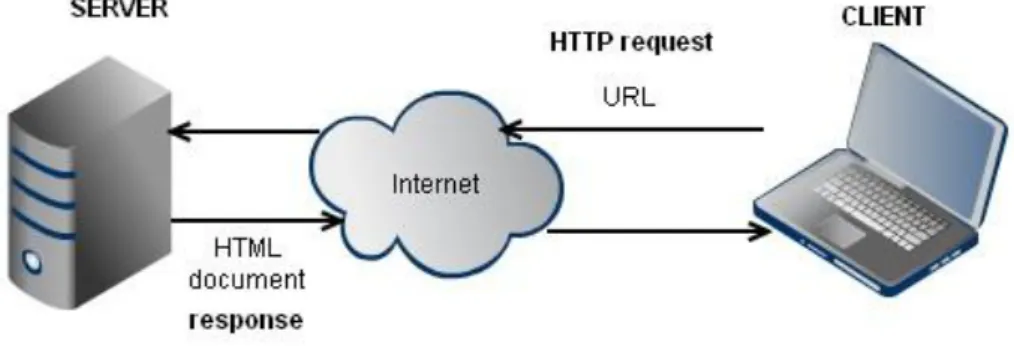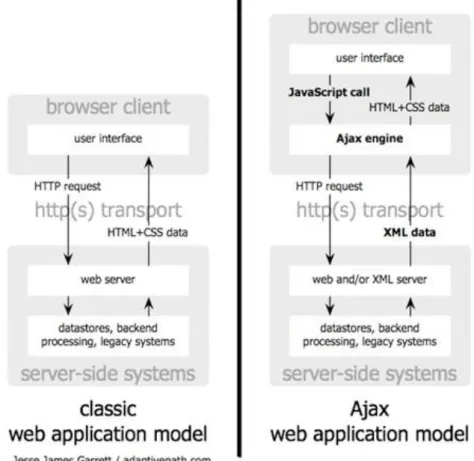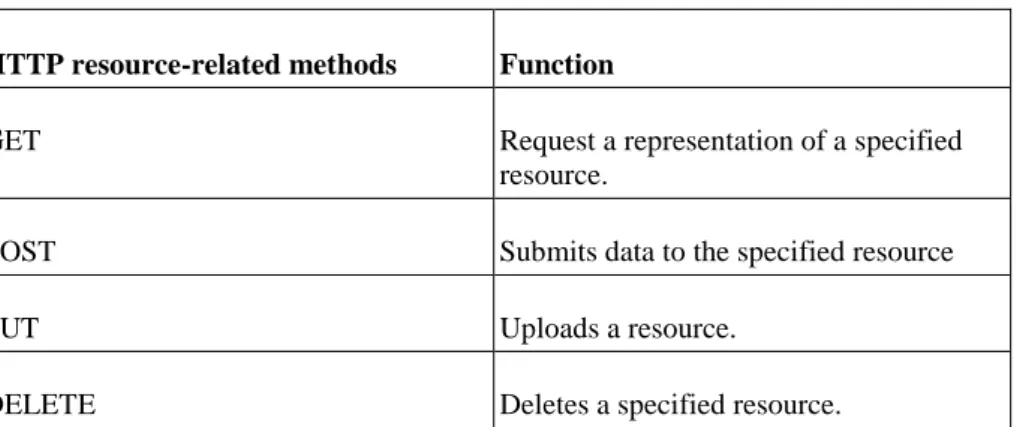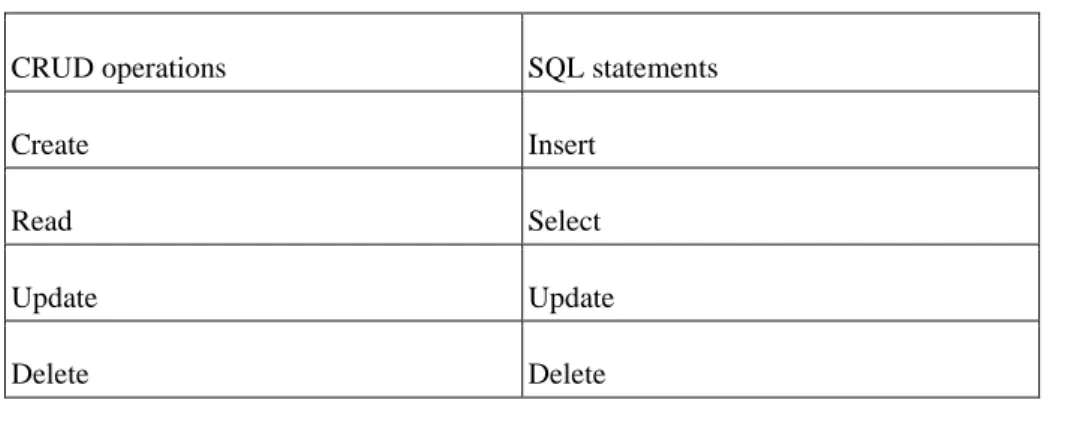Application Development in Web Mapping 1.
Web Technologies and Geospatial Standards
László Kottyán
Application Development in Web Mapping 1.: Web Technologies and Geospatial Standards
László Kottyán Lector: Antal Guszlev
This module was created within TÁMOP - 4.1.2-08/1/A-2009-0027 "Tananyagfejlesztéssel a GEO-ért"
("Educational material development for GEO") project. The project was funded by the European Union and the Hungarian Government to the amount of HUF 44,706,488.
v 1.0
Publication date 2010
Copyright © 2010 University of West Hungary Faculty of Geoinformatics Abstract
In AWD Module 1 an overview is given about the client/server architecture of Web, some highlighted technologies and the OGC standards.
The right to this intellectual property is protected by the 1999/LXXVI copyright law. Any unauthorized use of this material is prohibited. No part of this product may be reproduced or transmitted in any form or by any means, electronic or mechanical, including photocopying, recording, or by any information storage and retrieval system without express written permission from the author/publisher.
Table of Contents
1. Web Technologies and Geospatial Standards ... 1
1. 1.1 Introduction ... 1
2. 1.2 Web technologies ... 1
2.1. 1.2.1 Client ... 2
2.2. 1.2.2 Communication ... 2
2.3. 1.2.3 Server ... 3
2.4. 1.2.4 Terms ... 3
2.4.1. 1.2.4.1 WWW ... 4
2.4.2. 1.2.4.2 HTTP ... 4
2.4.3. 1.2.4.3 HTML ... 5
2.4.4. 1.2.4.4 HTML5 ... 5
2.4.5. 1.2.4.5 CSS ... 5
2.4.6. 1.2.4.6 JavaScript ... 6
2.4.7. 1.2.4.7 DHTML ... 6
2.4.8. 1.2.4.8 XML ... 6
2.4.9. 1.2.4.9 JSON ... 7
2.4.10. 1.2.4.10 GeoJSON ... 7
2.4.11. 1.2.4.11 Web Application Framework ... 7
2.4.12. 1.2.4.12 MVC ... 8
2.4.13. 1.2.4.13 Databases ... 8
2.4.14. 1.2.4.14 CRUD ... 8
2.4.15. 1.2.4.15 ORM ... 9
3. 1.3 Geopatial Standards ... 9
3.1. 1.3.1 WMS ... 9
3.2. 1.3.2 WFS ... 9
3.3. 1.3.3 CRS ... 9
3.4. 1.3.4 WKT and WKB ... 9
3.5. 1.3.5 GML ... 10
List of Tables
1-1. HTTP methods ... 4 1-2. HTTP status messages ... 4 1-3. CRUD operations and SQL statements ... 8
Chapter 1. Web Technologies and Geospatial Standards
1. 1.1 Introduction
The subject, Application development in Web Mapping is divided into seven modules. In the series of modules we would like to give you an overview about the web application development starting from the basics of WEB to some advanced Web mapping examples.
To become a web developer you need to learn about several technologies. To create custom webmapping applications you need to learn about geoinformation technologies. However writing a book which covers all the related technologies is not a good idea, it would fill thousands of pages. Moreover these pages have already written by others. Therefore the modules will highlight the most important terms, give practical examples and refer to other readings on the WEB. This series is intended to be a scaffold which helps in the steps to starting your own development.
The list of topics:
Module 1: Web Technologies and Geospatial Standards Module 2: Spatial Data Storage
Module 3: WMS/WFS Server Module 4: Web Mapping Client Module 5: OWS application
Module 6: Web Application Framework Module 7: Web Mapping Application
In modules we will work with open source tools, technologies and open standards.
In Module 1 an overview is given about:
• the client/server architecture of Web
• the communication between browsers and web servers
• some highlighted terms in web technologies
• OGC standards
2. 1.2 Web technologies
The World Wide Web is the most innovative and most-used part of the Internet. On Web complex contents, videos, graphics, sounds, texts are available. Behind these contents there are versatile technologies which serve data to users or to other services.
A web developer should be familiar with most of the underlying technologies.
Web, like other services on the Internet, operates on a client/server model. Web browser, the client, requests information or resources from web servers. Servers handle the request and pass back the result to the browser. It is the basis of the communication on the Internet or generally in client/server environment.
The resources requested by browser most of the time are Hypertext Markup Language (HTML) documents. And a resource can be an XML or JSON document, image or any other content. On Web, for a browser request the
Web Technologies and Geospatial Standards
Hypertext Transfer Protocol (HTTP) is used. HTTP defines methods for the client/server communication (Figure 1-1.).
Figure 1-1.: Client/server communication
When we talk about how the Web works it is a clearer way to study the client-side, the server-side and the communication separately.
2.1. 1.2.1 Client
On client-side after a page loaded into the browser window, user can do basically two things to change the user interface, to do any interactivity:
a. send a new request to the server (or to another one), for example the user clicks on a link and a new page is loaded,
b. don't send a new request to the server but use the elements of the page for interaction, for example the user opens a drop-down menu or types a wrong value to a form text input field and an error message is displayed.
In the second case the client application or the client part of the web application is developed using DHTML or Flash1 technologies. Developing a web application the developer has to deal with both the server-side component of the application and the client-side one. The first development is generally called server programming the second is named browser scripting or client-side programming. What the user sees in the browser is the client part of the web application. In a certain context the client is named view. If the developer makes a decision to put more function to the client side the web application can become more interactive.
2.2. 1.2.2 Communication
The communication is initiated by the client with a request. Traditionally requests are served one by one. A modern way is using Ajax2 techniques. Ajax allows asynchronous communication with the server. User doesn't have to wait for the response as in case of the traditional way while the page is loading. With asynchronous communication only a part of the page is refreshed the other part is still available for the user. Refreshing only a part of a page takes less time and makes it possible to enhance user experiences similar to desktop software (Figure 1-2.).
1Wikipedia, Adobe Flash: http://en.wikipedia.org/wiki/Adobe_Flash
2 Jesse James Garrett: Ajax: A New Approach to Web Applications, http://www.adaptivepath.com/ideas/e000385
Web Technologies and Geospatial Standards
Figure 1-2.: Ajax (source: http://www.adaptivepath.com/ideas/e000385)
Using Ajax communication there is a c) option on client-side which combines the a) and b) cases and provides more interactivity. Ajax is a key technology to build Web 2.0 websites.
2.3. 1.2.3 Server
An HTTP request contains a URL which tells the server what to serve. Sometimes it tells exactly the path and the name of a document, for example:
http://www.example.com/documents/report.pdf http://www.example.com/documents/about.html http://info.cern.ch/hypertext/WWW/TheProject.html
If the server sends back these documents without any processing on data these are static contents.
Most of the time the content is varying. The same request results different responses after a wile or occasionally.
Usually the varying is in a database and the request determines what data should be served. The database backend requires additional programs on server-side which:
• decide how to process the request,
• connect to the database and select the right data or dataset,
• generate the document with data to be sent back.
If the data of web pages is stored in database, there is possibility to create, modify or delete data, consequently change the pages or part of the pages.
2.4. 1.2.4 Terms
Web Technologies and Geospatial Standards
After the review of the client/server model, the web technology - related terms will be explained. The list of terms is not in alphabetical order but it follows a 'simplest to complex' kind of logic.
2.4.1. 1.2.4.1 WWW
The World Wide Web (WWW, Web) was invented by Tim Berners-Lee at CERN in 1989.3 WWW is one of the services that run on Internet. Firstly the idea was that Web is a network of hyperlinked (connected) pages, documents. Some might think it is an old-fashion definition. After more than twenty years of evolution of Web the information sharing, collaboration and interoperability characterize it.
The contents on the Web are placed on web server computers. The World Wide Web Consortium4 (W3C) was founded for developing and maintaining Web standards in 1994.
2.4.2. 1.2.4.2 HTTP
HTTP5 (Hypertext Transfer Protocol) is an application-level protocol for distributed, collaborative, hypermedia information systems.
HTTP has been in use by the World Wide Web since 1990.
It has methods related to the resources identified by URLs (Table 1-1.).
Table 1-1. HTTP methods
HTTP resource-related methods Function
GET Request a representation of a specified
resource.
POST Submits data to the specified resource
PUT Uploads a resource.
DELETE Deletes a specified resource.
HTTP has status messages that might be returned to the browser. Table 1-2. lists some messages:
Table 1-2. HTTP status messages
Status message Description
200 OK The request is OK.
400 Bad Request The server did not understand the request
401 Unauthorized The requested page needs a username and
a password
403 Forbidden Access is forbidden to the requested page
404 Not Found The server can not find the requested
page
3 CERN, Where the Web was born: http://public.web.cern.ch/public/en/About/Web-en.html
4 W3C: http://www.w3.org
5 HTTP/1.1: http://www.w3.org/Protocols/rfc2616/rfc2616.html
Web Technologies and Geospatial Standards
500 Internal Server Error The request was not completed. The server met an unexpected condition
503 Service Unavailable The request was not completed. The server is temporarily overloading or down
2.4.3. 1.2.4.3 HTML
HyperText Markup Language (HTML) is referred to as a language of the Web. HTML is used to describe Web pages with markup syntax. For marking of web page content tags are used. A tag is a keyword surrounded by angle brackets like <html>. A markup normally has opening and closing tags:
<b>bold text </b>
Closing tag is marked with an additional / character. The example on a web page displays like this:
bold text
Sometimes markup has no content and has only one tag like the tag which defines a single line break:
<br />
Tags can contain attributes:
<a href="index.htm" > This is a link </a>
Attributes have a name="value" syntax. In the example href is an attribute with "index.html" value.
The HTML document has two distinct parts: head and body.
<html>
<head>
<title> Title </title>
</head>
<body>
<p> The content is here </p>
</body>
</html>
Elements inside <head> can include scripts, instruct the browser where to find style sheets, provide meta information and more. Elements inside <body> are displayed on web pages.
HTML 4.01 became a standard in 1999.
2.4.4. 1.2.4.4 HTML5
HTML5 is the next generation of HTML. Some elements of HTML 4.01 are deleted or re-written in HTML5. It also defines new elements for better structure, drawing, media content and better form handling.
2.4.5. 1.2.4.5 CSS
CSS (Cascading Style Sheets) used to define how to display HTML elements.
A CSS style has two main parts: a selector, and one or more declarations (Figure 1-3.):
Web Technologies and Geospatial Standards
Figure 1-3. CSS syntax (source: http://www.w3schools.com/css/css_syntax.asp) The selector is normally the HTML element you want to style.
Each declaration consists of a property and a value.
The property is the style attribute you want to change. Each property has a value.6
2.4.6. 1.2.4.6 JavaScript
JavaScript is an object-oriented, dynamic, scripting language for client-side programming and implemented in most web browsers.
JavaScript:
• adds interactivity to HTML pages,
• changes Html elements, styles,
• used to preprocess data on the client before submission to a server,
• communicates with web server.
JavaScript code can be placed in HTML file or in external files.
2.4.7. 1.2.4.7 DHTML
DHTML (Dynamic HTML) is not a language. It is a term to describe the combination of HTML, CSS and JavaScript. DHTML allows developers to add animations, visual effects to pages and manipulate HTML elements.
2.4.8. 1.2.4.8 XML
eXtensible Markup Language (XML) is to transport and store data. It uses tags like HTML but not for displaying content. XML needs processing tools for displaying the content. XML defines the structure of data and contains data. XML has strict rules:
• XML documents must have a root element
• XML elements must have a closing tag
• XML tags are case sensitive
• XML elements must be properly nested
• XML attribute values must be quoted
XML doesn't have predefined tags it should be defined by the author, developer. It means that XML is for creating new languages for specific applications.
Some XML languages:
6W3Schools, CSS Syntax: http://www.w3schools.com/css/css_syntax.asp
Web Technologies and Geospatial Standards
• XHTML: HTML with strict XML rules
• Geographic Markup Language (GML): a language for describing geographical features
• DocBook: a markup language for technical documentation
• MathML: a markup language for mathematical notation
2.4.9. 1.2.4.9 JSON
JSON7 (JavaScript Object Notation) is a lightweight data-interchange format. It is for data transfer like XML but can be read with any programming language, no need for special processing toolset to work with.
JSON is built on two structures:
• A collection of name/value pairs. In various languages, this is realized as an object, record, struct, dictionary, hash table, keyed list, or associative array.
• An ordered list of values. In most languages, this is realized as an array, vector, list, or sequence.
2.4.10. 1.2.4.10 GeoJSON
GeoJSON is a data-interchange format for a variety of geographic data structures. GeoJSON can be used to represent a geometry, a feature, a collection of geometries, or a collection of features. The geometry types supported in GeoJSON are Point, LineString, Polygon, MultiPoint, MultiLineString, MultiPolygon and GeometryCollection. Features in GeoJSON are geometry objects with additional properties. A geometry collection represents a list of geometries and a feature collection represents a list of features.8
Here is a sample GeoJSON data displayed in browser (Figure 1-4.):
Figure 1-4.: GeoJSON dataset
2.4.11. 1.2.4.11 Web Application Framework
7JSON: http://www.json.org/
Web Technologies and Geospatial Standards
A web application is a software application which is accessed through a Web browser, using a http connection for information retrieval or display over a network.
A framework is the foundation of a web application. It can provide several useful tools to developers, including:
- database abstraction, - templating system,
- serving and routing tools for client-server communication, - user session management.
A framework defines the architecture of an application which structure helps the developers to build applications according to a particular logic.
2.4.12. 1.2.4.12 MVC
Model-View-Controler9 (MVC) architecture separate three parts of an application:
• Model is responsible for representing data,
• Controller makes the functionality or business logic,
• View represents the user interface.
The parts communicate with each other. According to the implementation of MVC there are some different interpretations of it. One interpretation is that Controller can communicate with Model and View but Model and View are never in direct relationship.
2.4.13. 1.2.4.13 Databases
In web development, the most popular database management systems are open source.
MySQL10 was initially released in 1995 by MySQL AB.
The first public version of the open source PostgreSQL11 was released in 1989. It is developed by PostgreSQL Global Development Group community. With PostGIS12 extension it is widely used in the GIS field.
2.4.14. 1.2.4.14 CRUD
The basic logical operations on data are create, read, update and delete (CRUD)(Table 1-3.). For example, on user level a read can be a listing, finding or any other function what reads data from database.
Table 1-3. CRUD operations and SQL statements
CRUD operations SQL statements
Create Insert
Read Select
Update Update
Delete Delete
9Trygve Reenskaug: MVC : http://heim.ifi.uio.no/~trygver/themes/mvc/mvc-index.html
10MySQL: http://www.mysql.com/
11PostgreSQL: http://www.postgresql.org
12PostGIS: http://postgis.refractions.net/
Web Technologies and Geospatial Standards
2.4.15. 1.2.4.15 ORM
In MVC, the Model mostly represents one table in the application database. One table is one Model class and one record (or tuple) is one object and one column (or field) is one attribute in Model class.
This kind of relationship between the relational database world and the object-oriented world is named Object- Relational Mapping (ORM). The model provides methods to create, read, update or delete data in database.
Even more, a Model can handle the relationships in database.
3. 1.3 Geopatial Standards
The Open Geospatial Consortium (OGC) is an international industry consortium to develop publicly available standards in the GIS domain. Several open source and commercial applications follow these standards to store, process and visualize spatial and related data. OGC standards13 are available at no cost to everyone.
Browsing on OGC pages we find different document types:
• OpenGIS Implementation Standard: It is a technology dependent standard for application programming interfaces and related standards based on the Abstract Specification or domain-specific extensions to the Abstract Specification. There are five types of standard documents: Interface, Encoding, Profile, Application Profile, and Application Schema.
• Abstract Specification: It describes and/or models an application environment for interoperable geoprocessing and geospatial data and services products.
• Best Practices: It contains discussion related to the use and/or implementation of an adopted OGC document.
• Discussion Papers: It contains not official discussion of some technology or standard.
• White Papers: A publication that states a position on a social, political, technical or other subject, often including a high-level explanation of an architecture or framework of a solution.
The OGC’s technical activities fall into three categories: the development of an abstract specification, the development of an implementation specification, and the specification revision process. There are more than 30 standards available.
3.1. 1.3.1 WMS
The OpenGIS Web Map Service (WMS) is an OGC standard which produces maps of spatially referenced data dynamically from geographic information. This international standard defines a map to be a portrayal of geographic information as a digital image file suitable for display on a computer screen.
3.2. 1.3.2 WFS
The OpenGIS Web Feature Service (WFS) is an OGC standard which allows for requests of geographical features across the web using platform-independent calls.
3.3. 1.3.3 CRS
Coordinate Reference Systems are defined in the OGC Abstract Specification: Topic 2 - Spatial Referencing by Coordinates. This document also describes coordinate transformations and coordinate conversions between two different coordinate reference systems.
3.4. 1.3.4 WKT and WKB
OGC specification defines two standard ways to describe spatial objects: the Well-Known Text (WKT) form and the Well-Known Binary (WKB) form. Both WKT and WKB include information about the type of the object and the coordinates.
Web Technologies and Geospatial Standards
Some WKT examples:
POINT(0 0)
LINESTRING(0 0,1 1,1 2)
POLYGON((0 0,4 0,4 4,0 4,0 0),(1 1, 2 1, 2 2, 1 2,1 1)) MULTIPOINT(0 0,1 2)
MULTILINESTRING((0 0,1 1,1 2),(2 3,3 2,5 4))
MULTIPOLYGON(((0 0,4 0,4 4,0 4,0 0),(1 1,2 1,2 2,1 2,1 1)), ((-1 -1,-1 -2,-2 -2,-2 -1,-1 -1)))
GEOMETRYCOLLECTION(POINT(2 3),LINESTRING(2 3,3 4))
The WKB representation of POINT(5 0): 010100000000000000000014400000000000000000
3.5. 1.3.5 GML
GML, or the Geographic Markup Language is an XML encoding for the transport and storage of geographic information, including both the spatial and non-spatial properties of geographic features. GML is intended to provide a means of encoding spatial information for both data transport and data storage, especially in a wide- area Internet context.
Bibliography
Gralla, P.- Troller, M.: How the Internet Works, Eighth Edition, Que Publishing, 2007 OGC: OGC Reference Model, http://www.opengeospatial.org/standards/orm
W3Schools: W3Schools Tutorials, http://w3schools.com/




